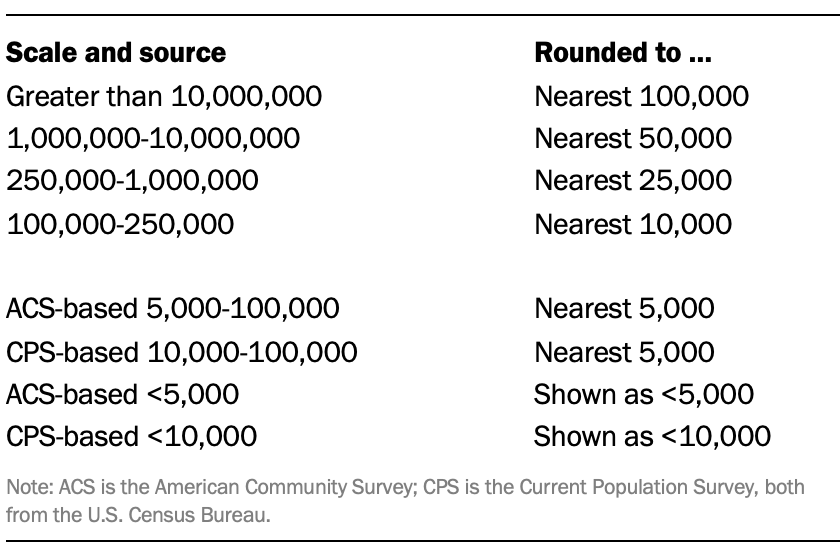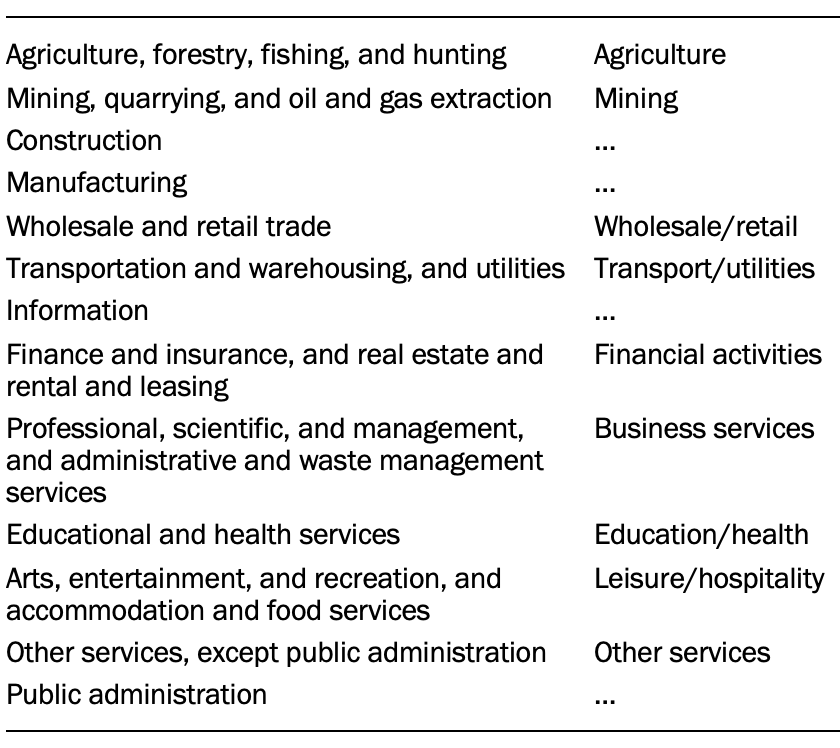This report presents estimates of the number of unauthorized immigrants in the United States as of July 2023 and for earlier years. These estimates supersede all previously published Pew Research Center estimates. This appendix provides details on how the estimates are rounded and definitions of various concepts used in the report.
This methodology section is the third of three. Two others describe other parts of the report’s methodology. The first (Methodology A) describes the methods used to produce the estimates of the unauthorized immigrant population and its characteristics. The second section (Methodology B) describes the principal survey data used to produce the estimates and modifications made to the underlying surveys.
Rounding of population estimates
All estimates for unauthorized immigrant populations are presented as rounded numbers to avoid the appearance of unwarranted precision in the estimates. The rounding conventions for unauthorized immigrant estimates, dependent somewhat on data sources, are:

Estimates for 1990 are based on the 1990 decennial census and use rounding conventions based on the American Community Survey (ACS). These same conventions are used to round the 90% confidence interval limits, presented as “Range (+ or -),” with one exception: limits that round to less than 5,000 are rounded to the nearest 1,000. For state- and national-level data on the total population or total foreign-born population, figures are rounded to the nearest 10,000.
Unrounded numbers are used for significance tests, for plotting charts and for computations of differences and percentages. Where differences are reported, they are computed from unrounded estimates and then rounded. Because each figure is rounded separately, the rounded estimates may not add to rounded totals. Similarly, percentages computed from rounded numbers may differ from the percentages shown in this report.
Countries and regions of birth
The estimates presented in this report are based on Census Bureau data from the American Community Survey (ACS) and Current Population Survey (CPS). Accordingly, the countries of birth we report are limited to those for which survey data is provided. Defining regions of the world and, in some cases, specific countries using the various data sources requires grouping areas into identifiable units and “drawing lines” on the world map. We have defined our geographic groups using the United Nations and DHS definitions, plus Census Bureau groupings for racial groups (e.g., Asian and Middle Eastern-North African). Countries and areas as reported by the ACS (IPUMS) and the CPS are grouped into the regions used in this report as. Note that the list below uses the country names directly from the IPUMS and CPS codes and may differ from geographic naming and grouping conventions used in other Pew Research Center publications:
Mexico – Reported separately because of its prominence in migration flows to the U.S.
Central America – Belize, Costa Rica, El Salvador, Guatemala, Honduras, Nicaragua, Panama, Central America
Caribbean – Antigua-Barbuda, Bahamas, Barbados, Cuba, Dominica, Dominican Republic, Grenada, Haiti, Jamaica, Puerto Rico, St. Kitts-Nevis, St. Lucia, St. Vincent, Trinidad & Tobago, U.S. Virgin Islands, Caribbean not specified, West Indies not specified, Americas not specified
South America – Argentina, Bolivia, Brazil, Chile, Colombia, Ecuador, Guyana, Paraguay, Peru, Uruguay, Venezuela, South America not specified
Canada-North America – Bermuda, Canada, North America
Europe – Albania, Armenia, Austria, Azerbaijan, Azores, Belgium, Bosnia, Bulgaria, Belarus, Croatia, Cyprus, Czechia, Czechoslovakia, Denmark, England, Estonia, Finland, France, Germany, Great Britain, Greece, Holland, Hungary, Iceland, Ireland, Italy, Kosovo, Latvia, Lithuania, Macedonia, Moldavia, Montenegro, Netherlands, Northern Ireland, Norway, Poland, Portugal, Republic of Georgia, Romania, Russia, Scotland, Serbia, Slovakia, Spain, Sweden, Switzerland, Ukraine, United Kingdom, USSR, Yugoslavia, Europe not specified
Asia – Afghanistan, Bangladesh, Bhutan, Burma, Cambodia, China, Hong Kong , India, Indonesia, Japan, Kazakhstan, Kirghizia, Korea, Laos, Malaysia, Mongolia, Nepal, North Korea, Pakistan, Philippines, Singapore, Sri Lanka, South Korea, Taiwan, Thailand, Uzbekistan, Vietnam, Asia not elsewhere classified (n.e.c.), East Asia not specified
Middle East-North Africa (MENA) – Algeria, Egypt, Iran, Iraq, Israel, Jordan, Kuwait, Lebanon, Libya, Morocco, Palestine, Saudi Arabia, Syria, Tunisia, Turkey, United Arab Emirates, Yemen Arab Republic, Middle East, North Africa not specified
Sub-Saharan Africa – Cameroon, Cape Verde, Congo, Eritrea, Ethiopia, Gambia, Ghana, Guinea, Ivory Coast, Kenya, Liberia, Nigeria, Rwanda, Senegal, Sierra Leone, Somalia, South Africa (Union of), South Sudan, Sudan, Tanzania, Togo, Uganda, Zaire, Zambia, Zimbabwe, Africa not specified or n.e.c., Eastern Africa not specified or n.e.c., Other Africa, Western Africa not specified
Oceania and other – American Samoa, Australia, Fiji, Guam, Marshall Islands, Micronesia, New Zealand, Northern Mariana Islands, Samoa, Tonga, Elsewhere, Other n.e.c.
This list represents only those countries and areas identified in the microdata for the ACS (from IPUMS) and the CPS; it does not include all countries. For the CPS, individuals originally reported as born “Elsewhere” were assigned specific countries of birth to ensure that all foreign-born respondents are classified by country or region of birth. The assignment process uses reported countries of birth of respondents’ parents, other family members and information on race and Hispanic origin.
Not all individuals born in these areas outside the 50 states and the District of Columbia are part of the foreign-born or immigrant population. Some of the areas above are U.S. territories, and people born in those areas are U.S. citizens. In addition, individuals born outside the U.S. and its territories are citizens at birth if they have a U.S.-citizen parent. This group is known as “born abroad of American parents” and is not part of the foreign-born population.
Specific countries of birth
For this report, several specific countries are combined for both geopolitical reasons and reporting in the surveys. China, Hong Kong and Taiwan are combined and reported as “China” because of potential inconsistencies between the administrative data sources and the surveys and because of concerns over consistency of reporting on the part of respondents. “Korea” includes responses of Korea, North Korea and South Korea; the vast majority of Korean immigrants in the U.S. are from South Korea. “Dominican Republic” includes persons born in the Dominican Republic and a very small number reported as born in Dominica. Most of the respondents in the latter group appear to have been miscoded.
When data are reported for the “Former USSR,” the total includes persons reporting Armenia, Azerbaijan, Belarus, Estonia, Kazakhstan, Kirghizia, Latvia, Lithuania, Moldavia, Republic of Georgia, Russia, Ukraine, USSR and Uzbekistan. The remaining republics of the former USSR are not identified separately in the datasets. Reports of Czechoslovakia, Czechia and Slovakia are combined as “Czechoslovakia.” The “United Kingdom” includes persons reporting England, Great Britain, Northern Ireland, Scotland and United Kingdom; other areas of the United Kingdom (such as Wales) are not reported separately in the datasets.
A small number of unauthorized immigrants are from Oceania and from a residual “Other” category shown in ACS data. The total of the residual “Other” and Oceania is included in the overall national estimates but not shown separately in any tables or figures. Mexico, Central America, Caribbean and South America comprise “Latin America.”
Labor force and workers
The labor force includes all people ages 16 and older who are working or looking for work. The ACS and CPS also collect information on respondents’ employment status, their occupations and the industries where they work. Occupations are the kind of work people do at their jobs; so, “teacher,” for example, is an occupation. Industries are the kind of business conducted by the person’s employer; so, a teacher could work in a “university,” an “elementary school” or even a company selling insurance.
Some occupation groups are similar to industry categories. For example, many workers with construction occupations work in the construction industry. But the construction industry also employs people in other occupations, such as manager or accountant.
For the analyses of occupations and industries, we exclude people who did not report an occupation or industry. Our analysis of the civilian labor force also excludes people in the military or with a military occupation. These exclusions drop slightly more than 1% of the total labor force of roughly 175 million– 2.0 million are excluded from the occupation analyses and 2.6 million from the industry analyses. About 140,000 unauthorized immigrants, or 1.4% of those in the workforce, are excluded from this analysis because they do not report an occupation or industry; unauthorized immigrants are generally not eligible to be in the military or to hold military employment, so they are not excluded for that reason. Unemployed people are only excluded if they do not report an occupation or industry, although most do report one.
Occupation and industry category labels
The U.S. Census Bureau has three levels of aggregation each for occupation and industry. At the highest level are 11 classifications for “major occupation” groups (10 for civilians, plus the armed forces). At the next level are 23 “detailed occupation” groups, though eight of them are identical to the “major” groups; the three major occupation groups for management, professional and service occupations are subdivided into 15 smaller, detailed groups. Finally, there are a large number of very specific occupation categories – over 500 in the ACS – that can be grouped into either the “detailed” or “major” groups. So, for example, the code for “aerospace engineers” (1320) is part of the detailed category for “architecture and engineering occupations” which, in turn, is part of the major category of “computer, engineering, and science occupations.”
For industries, the highest level has 14 “major industry” groups (13 for civilians and one for the armed forces). At the next level are 22 “detailed industry” groups with seven identical to the “major” groups. Finally, there are almost 270 very specific industry categories in the ACS that can be grouped into either the “detailed” or “major” groups. So, for example, the industry called “retail bakeries” (code 1190) is part of the detailed category for “nondurable goods manufacturing” which, in turn, is part of the major category of “manufacturing.”
The analyses presented here use the “major” categories for both occupations and industries. Some data is presented elsewhere for the very specific occupations and industries with the highest concentrations of unauthorized immigrants.
For ease of presentation, the full titles of many occupation and industry categories have been condensed from the Census Bureau’s terminology in some figures and text.
The condensed occupation labels are shown as:

The condensed industry labels are displayed as:

References in the text, text charts and tables can be checked against the lists above.
More information on the industry and occupation categories from the Census Bureau and IPUMS can be found here:
https://www.census.gov/topics/employment/industry-occupation/guidance/indexes.html
https://usa.ipums.org/usa/volii/ind2022.shtml
https://usa.ipums.org/usa/volii/occ2018.shtml
Children, adults and spouses
In this report, the term “spouse” encompasses both married couples and unmarried partners, unless otherwise indicated. Because of limitations in reporting family relationships in the ACS, essentially all unmarried partners include the individual who is called the head of a household with their partner, but not other unmarried couples within the household.
In most uses in this report, “children” are defined as individuals younger than 18 who are not the head or spouse in a family unit. This means that individuals younger than 18 who have their own children or are the spouse/partner of another household member are not included in the child population. “Adults” are people who are not “children,” that is, they are 18 years old or older or are a parent/spouse/partner of someone else in the household.
Adult children of unauthorized immigrants are individuals aged 18 and older who live in a household with at least one parent who is an unauthorized immigrant. People (either 18 and older or under 18) who have an unauthorized immigrant parent but do not live with that parent cannot be classified as the child of an unauthorized immigrants because there is no information in the Census Bureau’s data linking them with their parents. Thus, the estimates presented here for children of unauthorized immigrants are smaller than the number of people who have an unauthorized immigrant parent.




